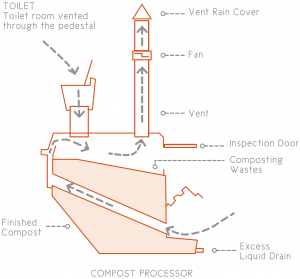If you’re considering purchasing a composting toilet there’s a lot you need to take into consideration and the multitude of choices available on the internet can sometimes make it difficult to figure out what type of composting toilet would be best for you.
In this article we explain the different types of composting toilets available on the market, how they’re used and how difficult or easy they are to install.
If you’re considering purchasing a composting toilet, this is an invaluable post that will guide you through the different options and types of composting toilets available.
The different types of composting toilets available
Whilst there are many different variations of toilet sizes and gizmos and additions that can be added to your composting toilet, they can really be divided into two categories – Split Systems and Self Contained (also called all-in-one).
Split Systems
These types of composting toilets are quite literally split into two sections called the ‘pedestal’ which is above the floor and the ‘tank‘ which is below the floor. The pedestal is the seat where you sit to do your business and the tank is where all the waste is stored to go through the composting process. These types of toilets are great for homes, outhouses, national parks or clubhouses and sports clubs , etc that have accessible space under the floor. Split systems usually have a larger capacity and are installed in areas where multiple people are going to be using the bathroom.
Self Contained Systems
Self contained units are an all in one system that has the container and pedestal built into the one system. These are great for homes that are limited on space or don’t have a downstairs area for a tank to go. Many people use self contained composting toilets in small homes or tiny houses, caravans, RVs and motorhomes, boats or single level homes that have been built on a concrete slab.
Continuous vs Batch
Both split and self contained systems can be further categorised into “continuous” and “batch systems”. In a continuous system, poop goes in one end and humus comes out the other. With a batch system, compost chambers are filled and then changed for an empty chamber so the compost is done in batches.
How Split System Composting Toilets Work
 The process behind how a split system composting toilet works is very simple however, the composting process itself can be very interesting and somewhat technical. The toilet system is fairly easy to install and setup – it’s the composting process that introduces many different elements, organisms, bacteria and fungi to work in harmony to produce the rich humus similar in chemical makeup and look / feel to topsoil.
The process behind how a split system composting toilet works is very simple however, the composting process itself can be very interesting and somewhat technical. The toilet system is fairly easy to install and setup – it’s the composting process that introduces many different elements, organisms, bacteria and fungi to work in harmony to produce the rich humus similar in chemical makeup and look / feel to topsoil.
Here’s a simple diagram that explains the different components of a split ‘continuous’ system composting toilet.
As you can see there’s the pedestal component that works pretty much the same as a standard ‘flush’ toilet system (without the flush of course).
Then there’s the initial chamber where most of the waste is caught. There is also a drain for excess liquid to escape (a sloppy composting pile will quickly start to smell and can kill off important bacteria and moulds in the composting pile). The vent and fan will help to evaporate excess liquid from your pile and assist in keeping the composting pile at a regulated temperature. The secondary chamber is where the finished product ends up. Composting toilet will produce a humus like product that’s almost indistinguishable from rich, organic topsoil.
How a self contained (Batch) composting toilet works
As you can see from this image a self contained composting toilet has everything you

need contained in the one system. They look very similar to a traditional toilet and many people won’t even notice that it’s a composting toilet until they start using it!
Because the chambers are much smaller than a split system, often self contained composting toilets will come with 1-2 chambers so you can swap them out when one gets full. Additional chambers can be purchased if you’re expecting a lot of people (holidays or family reunions, etc).
What composting toilet should I buy?
Well as you can see there’s a lot of different options available for you, but don’t worry, how many people using it and the type of home you have can narrow down the range of solutions so you’re able to make a clearer decision.
Let’s take a look at some common scenarios and the type of composting toilet that would suit them.
Family home no underfloor space with 2-5 people
If you’re a family home with two adults and a couple of kids a self-contained composting toilet is perfect for you.
Family home with underfloor space with 2-5 people
If you’re a family home with two adults and a couple of kids and underfloor space a split system is perfect for you.
Family home with more than 5 people
Either consider multiple self-contained systems if you don’t have any underfloor space or a split system such as a Clivus Multrum CM10 or a Clivus Multrum CM HP
Small clubhouse or sports club with 10-30 people
With this amount of people using the system, this will definitely require a split system like the Clivus Multrum CM tank range.
National Park or large club
A split system is a must for this amount of people. A larger split system like the CM40 will do the job along with the possibility of installing a restroom building.
Note that split systems also work well in multi-story homes. You just need an extended chute.

